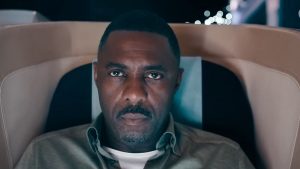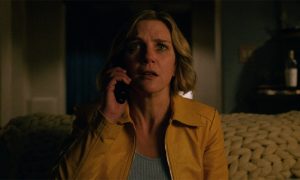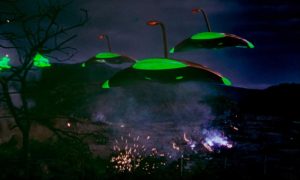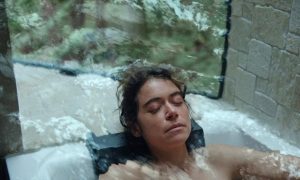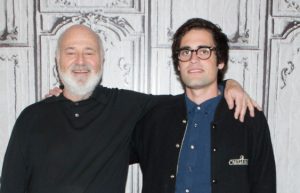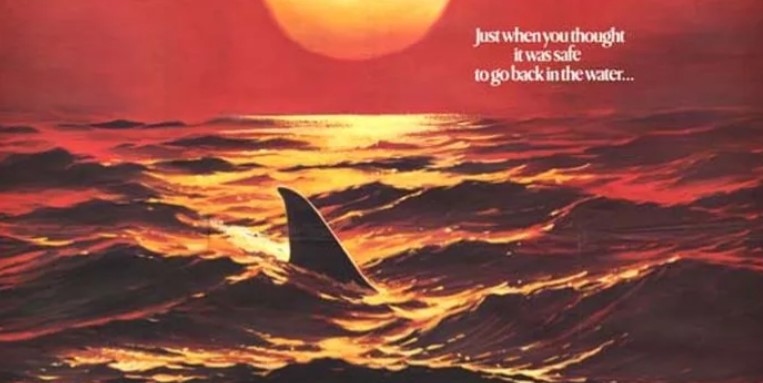
We can’t deny it anymore, we really are in something of a Jaws season here at the Last Movie Outpost. In the last month we talked about why Jaws is just better than all other shark movies. We argued about an unpopular movie opinion about Jaws 3D, and we also looked at the history behind those terrble VFX. Then we examined what went wrong with Jaws The Revenge.
Now we turn our attention to Jaws 2, clearly the best of the sequels. However, it was not all plain sailing for this follow-up. Here, resurrected from our former site, we take a deep dive into Jaws 2 and take you through a very different story outline, bringing to light the movie we nearly got instead. This is the lost Jaws 2.
Just When You Thought It Was Safe To Go Back In The Water
We all know Jaws 2, the first really huge Hollywood sequel. Sure, there were sequels before such as The Godfather Part II, but nothing quite on this scale. When Jaws went huge in the summer of 1975, practically inventing the summer tentpole blockbuster in the process, a sequel was all but guaranteed.
Producers David Brown and Richard D. Zanuck were originally not keen. When they realized that Universal would simply get someone else to produce the film if they did not, they decided to sign up to do it.
The original plan was for Quint’s son to arrive in Amity to collect his father’s share of the bounty, and he would end up teaming up with Brody’s oldest son to fight a new shark. This idea was scrapped. Spielberg was approached to return as the director but, in October 1975 he told the San Francisco Film Festival that:
“…making a sequel to anything is just a cheap carny trick.”
He declined the offer, feeling he had already made the definitive shark movie and not wanting to experience the issues and stress he had on the first movie all over again.
“I would have done the sequel if I hadn’t had such a horrible time at sea on the first film.”
The studio kicked off an 18-month pre-production process during which several ideas were kicked around. One of them was a prequel idea from Howard Sackler. Sackler contributed to the first film’s script but chose not to be credited. His idea for Jaws 2 was to base it on the sinking of the USS Indianapolis, and show where Quint got his hatred of sharks from.
Universal president Sidney Sheinberg thought Sackler’s treatment for the film was intriguing, but he ultimately rejected the idea. Roy Scheider was attached due to a contractual wrangle with Universal. Murray Hamilton was available and Lorraine Gary was married to Sheinburg. The orders from the studio were for a sequel, not a prequel, and to utilize these three as leads.
John D. Hancock on the set of Jaws 2
Sackler recommended John D. Hancock to the studio. Kansas City-born and Harvard educated, Hancock had earned an Academy Award nomination for his short film Sticky My Fingers…Fleet My Feet in 1971. This led to his first feature film, Let’s Scare Jessica to Death. He followed that up by directing Michael Moriarty and Robert DeNiro in the baseball-themed drama Bang the Drum Slowly.
Hancock was hired, along with his wife Dorothy Tristan who would work on the script with Sackler. That script is the foundation of this lost sequel and the version of Jaws 2 that we never got to see.
We Need Summer Dollars
The Sackler and Tristan script that Hancock set out to make was practically unrecognizable from the final movie. It is darker, much more complex, and does not contain the final act that feels like it owes its approach to a teen-slasher movie. The tone is completely different.
How do we know this? Because it is this script that was turned into a novelization ready for the release of the movie. Written by Hank Searls, to read it without knowing this background is confusing for the uninitiated. It bears almost no resemblance to the movie in any way, save the location, a few character names, and the fact there is a shark in it.
When the studio changed things, there was simply no time to rewrite the novelization, so the book shipped anyway.
So what was to have happened in the movie Hancock never got to make? It starts with the familiar.
Two weekend divers, doctors out from Rhode Island, are on a weekend dive expedition on their boat. Slightly buzzed on whisky and having had some of their own meds to help take the edge off, they check their charts. They have heard of the town on the shoreline, but can’t quite remember why. When they discover the wreck of the Orca during their dive they suddenly remember. However, they are not alone down there…
That town on the shoreline is Amity, and Amity is not how we remember it from the movies. It is dead. A ghost town. The Troubles, as the locals refer to the shark incidents, have killed the town. Shops are shuttered. Foreclosure notices are peppered everywhere. Summer homes remain un-rented. Businesses have folded. Litter blows down nearly deserted streets. Welfare is a way of life.
Mayor Larry Vaughan is haggard, barely clinging to his office in the face of the fallout from that summer three years ago. However, there are signs of hope.
A new water sports business has recently opened in the town, owned by ex-Navy diver Tom Andrews. He is a giant of a man from California who has moved to Amity to open his shop, launch his dive school, and actively play a part in his local community. He has bonded with Police Chief Martin Brody as they have a similar desire to see the town thrive again.
Tom Andrews in his much reduced role in the finished movie
Another big chance for the town to recover is the building of condos, beachfront villas, and a hotel called the Amity Shores development. Developer Len Petersen is behind the project and he is waiting on a gaming license to be approved by state legislators up in Albany to include a casino in his plans.
The town’s young teenage population is getting into scuba in a big way thanks to the inaugural class from Tom Andrews. Young Mike Brody in in this first class. His pool work is finished and it is time to get his permission slip signed to take to the sea. This is where we find Chief Brody, with understandable concerns after the events of Jaws.
In this script, Brody is very different to the movie version of Jaws 2. He still carries guilt from a failure to drive through the beach closures after Chrissie died, so he still feels responsible for the other deaths. Alex Kintner among them.
Thoughts of another shark out there do enter his mind, though he rationally dismisses them. In the movie, he is almost obsessed. In this early version of the story, he was much more understated. When the divers are reported missing, he has a momentary thought and then the many empty bottles of whisky and evidence of pills allow him to park these dark thoughts.
Tom Andrews helps him focus by underlining the issues of drinking, drugs, and diving.
Then a man and his wife disappear on a water-skiing trip.
The attack is much more complex in the early script than in the movie. The shark does not simply rise from the depths and pluck the unlucky skier from the surface. The boat driver sees the fin, knows what is happening, and tries to avoid the shark in a game of cat and mouse to save his wife.
When it does attack, the shark hits his wife again and again with echoes of the Chrissie attack in the first movie. Then it turns on the boat. He shoots the flare gun at the shark as it rams the boat and the force causes him to fall and miss, firing into the spare gas tank to cause the explosion.
The panicked woman pouring fuel on herself as she tries to pour it on the shark is entirely absent from this version of the story. This incident will also go on to be a major ongoing plot point.
From an observer’s point of view, this does not look like a shark attack, but simply a tragic accident, and Brody must investigate like the cop he is. There is an incident on the beach where a New York cop on vacation shoots his rifle at a seal pup that was causing his dog to go crazy at their beach house.
He has hit the seal once but claims it was an accident, the intention was to simply scare it away. With a mysterious explosion just offshore while this gunfire was happening on the beach, Brody wonders if there is a connection.
The injured seal is now evidence and ends up living in Brody’s garage where he is promptly named Sammy by a young Sean Brody.
Meanwhile, into Amity harbor, there is a cod run the likes of which people have never seen before. Pier fishermen are just plucking them from the water. Something out there is scaring the local cod to run in the harbor.
The whole story is presented as a mystery. We know there is a shark, and we are watching the town slowly get caught up with us. This removes a problem that exists in the movie. Would a town that went through The Troubles really be as dismissive if it looked like the same thing was happening again?
Here, in this version, Brody and his townsfolk don’t know a thing… yet.
We, the audience, know that the two divers didn’t overdrink and pop pills. We know the boat explosion wasn’t a tragic accident and that a vacationing cop didn’t catch the boat with a stray shot. We know why a seal pup has beached and won’t go back in the water and why the cod are running in Amity Harbor. We are just waiting for all involved to make the connection.
Brody is fairly convinced the visiting cop shot up his beach, clipped the boat, and caused the explosion. He also wonders if the cop might have taken some shots at divers, separated from their boat, emerging from the surf looking like seals in their dark wetsuits.
Driving home in the early evening along the coast road he spots something in the surf. His fear of water needs to be conquered as he wades out to retrieve the item, the portion of the gas tank from the boat complete with a hole in it.
In the movie, a spring-loaded burnt corpse is present for a jump scare repeat of the Ben Gardner’s head moment. In the early script and the book adaption, the shark is present just offshore, invisible to Brody and stalking him but unable to attack due to the shallow water.
This evidence seems to prove Brody’s theory that the cop was responsible for the explosion. He arrests the cop while forensics on the mainland do tests to confirm Brody’s supposition. In doing so, Brody unknowingly kicks off another major subplot. The mob is in Amity.
Len Petersen isn’t the only casino backer. Lifting a subplot directly from the original Benchley novel, here they are involved in Amity Shores with their dirty money. The cop Brody has arrested is connected upstate and is making waves in Albany. This could jeopardize the gaming license and impact their investment in Amity Shores.
Word is sent by the families. The small-town police chief can’t stop this. He needs to be dealt with.
Brody doesn’t know that he’s protected. Tony Moscotti, a senior figure in the families, has a summer house in Amity. When the town establishment, including the selectmen and Brody himself, were concerned about Moscotti and his presence in Amity, Ellen Brody let Moscotti’s eight-year-old son join the Amity Cub Scout pack, overruling the wishes of the selectmen and Brody.
Her argument is that the sins of the father should not impact a young boy who needs summer friends.
Len Petersen – the acceptable face of the Amity Shores development
Moscotti has never forgotten this act of kindness towards his son and holds Ellen in extremely high regard. He tries to lean on Brody to drop the charges against the cop. He also pushes back against the families who are all set to whack this two-bit small-town Chief.
You Yell Shark…
Meanwhile, a naval exercise is underway in Amity Sound involving a helicopter with dipping sonar. When a simmering teenage feud between Mike Brody and Larry Vaughan Jr. results in a swim chase and a fight out in the water, the commotion out past the breakers and over the ocean drop-off attracts the attention of the shark.
As it closes in to investigate, the naval helicopter has also spotted the boys and closes in to see if they are in trouble. The shark switches its attention to the helicopter due to the rhythmic berating of the blades and attacks the dipped sonar buoy.
The sudden, powerful jerk causes a blade vibration and auto-rotation. The helicopter dumps the buoy and attempts to make it back to their base, but ultimately crashes several miles away.
The sole survivor of the crash is killed by the shark as he floats among the wreckage some time later. Meanwhile, the navy wants their sonar buoy back and they launch a search including a reward to anyone who finds it. The inaugural scuba class want to join in the search and claim the prize.
The shark, Brody’s investigation, the mob, and the naval search all intertwine and now the whole story accelerates into its final third. At this point, Brody still does not know he has a shark problem again in Amity.
The ballistic forensics investigation proves that Brody is wrong. It was a flare gun, not a rifle, that entered the tank. Brody drops the charges, and as a result the anger of mob switches to to the vacationing cop who brought all this attention to the gaming license.
He tried to defend himself via a Mob lawyer, meaning he has to be dealt with. The cop comes up against a hitman at night on the beach. When the hitman tries to dispose of the bleeding body in the sea, they are both taken by the shark.
The missing divers camera has been retrieved from the sea bed under their boat and unlike in the movie, where Brody is present as the pictures are developed, the town pharmacist is alone. The pictures of the shark attacking the divers are clear. He reaches the conclusion that Brody lied about killing the first shark and it’s back.
He knows the town won’t survive this, so keeps quiet while he puts his business up for sale before the presence of the shark causes a property crash.
Unfortunately for him, the mob is entrenched in the local real estate market and an attempted blackmail leads to a violent misunderstanding, which means his secret goes with him to his grave.
Unlike the movie, there is no sailing as a substitute for teenage cruising culture here. It’s all about the scuba as Mike Brody conquers his fears to take part in his open water training. Andy is his buddy here and they become separated. Andy finds the abandoned sonar buoy while looking for Mike, but also has a close encounter with the shark.
Andy was a diver in this early version of the story, not a sailor
In a panic, Andy bolts for the surface and causes an embolism. He is barely conscious when pulled from the water and rushed back to shore to meet an ambulance. Unable to speak due to paralysis from the bends, he cannot warn anyone what happened beneath the surface.
Tom Andrews and Brody assume that he found the sonar buoy and surfaced too fast in his excitement. They take Andrews’ dive boat to find the buoy, planning to give the reward to Andy’s family to pay his medical bills.
Across the bay, the Cub Scouts have a boat in the annual Amity Regatta with Moscotti Jr and Sean Brody among the crew. A fog descends and the race is aborted but the leading boats, including Sean’s, do not hear the recall horns and continue onward. Trapped in a fog bank and unable to navigate back to shore, and with night falling, they raft up their boats and await rescue.
It is only at this point, while they are searching for the buoy, do Brody and Andrews encounter the shark.
The story is nearly at an end when Brody finally realizes what he, and the town, are facing. In 238-page novel adaption, Brody first sees the shark on page 212. This is when he sets off to rescue the children in the fog bank at dusk with the shark nearby.
The kids have anchored and some of them have snagged a certain electrical cable that fans of the movie version of Jaws 2 will be all too familiar with.
Whereas the teenagers are in peril for almost all of Act 3 of the movie, in this version the much younger children are menaced by the shark in a fairly short sequence right at the end.
I Don’t Intend To Go Through That Hell Again!
So what went wrong? What happened? There was a great story there. This early version of Jaws 2 was excellent. A hollowed-out town, a believable Brody, and three intertwining stories propel things along in a taught, but layered story. What is not to like?
Issues seemed to start when studio head Sid Sheinberg was unhappy with the relatively small part Ellen Brody had in the early script. His wife was in the role and he felt she should have gone out to assist the kids at the end with Chief Brody. The writers and the producers vehemently disagreed.
Hancock also faced production difficulties on Jaws 2 similar to those that had caused Spielberg to only narrowly avert a nervous breakdown on the set of the first movie.
The unreliable shark, the demands of the elements, and the complications of so much location shooting all took their toll. Hancock struggled with the demands of a high-profile, high-budget Hollywood production.
With the shooting underway but not proceeding to plan, and some concerns back at base developing over the dark tone of the movie, the studio viewed the rushes and the suits were horrified. Their worst fears were realized. Hancock and his wife were firm on their vision for the movie, so were making a very different movie to the one the studio envisaged. The studio reacted the only way studios know how.
Universal paused production, summoned the director and writer back to the studio in Hollywood, and fired them.
Carl Gottlieb, the script editing machine and screenwriter from the first Jaws movie, was summoned to rewrite the script and Jeannot Szwarc was brought in to direct. The production was still troubled, but they got it over the line. Meanwhile, the publicity tie-in book was locked and loaded, based on the old script with no time to rewrite, so it shipped.
All that remains of John D. Hancock’s work in the finished Jaws 2 is the parasailing scene, and a single sequence of shots. These, though, are potentially also the best shots in the movie.
In Amity Harbor at night some seabirds explode from the water in a panic. The tiller on a yacht slowly swings from the force of something big moving past the boat underwater. Just for a second, we glimpse something below the surface, just a shadow.
Finally, a fin emerges from the water as the shark patrols the harbor at night.
The quality of this brief sequence, dark, atmospheric, and full of foreboding, is a frustrating glimpse at the movie we perhaps could have got.
If Universal had more faith in Hancock and Tristan’s vision we could have seen a multi-layered movie with twists and turns set against the backdrop of a hungry shark just offshore Amity once again.
Instead, we got a teen-focused movie that, at times, feels like it has just replaced a machete-wielding mad-man with a shark.
Jaws 2 is a good movie and certainly the best of the sequels, but it is not a patch on the original. The Tristan and Sackler script, and the Searls novelization that was based on it, show that maybe something that had the potential to be truly special was lost.
Check back every day for movie news and reviews at the Last Movie Outpost
The post The Lost JAWS 2 appeared first on Last Movie Outpost.

